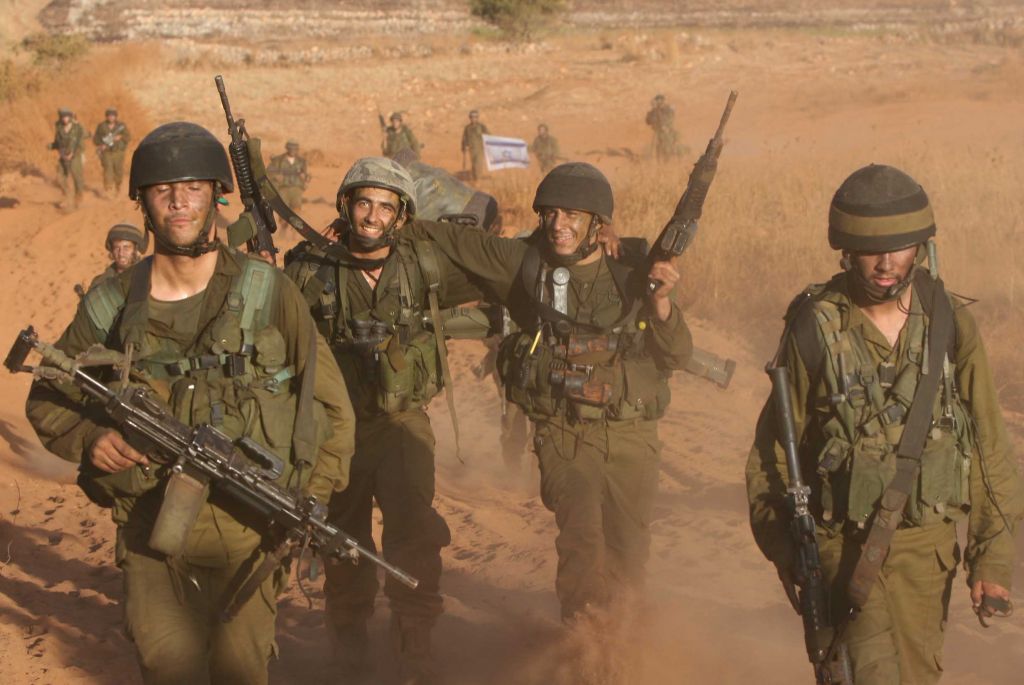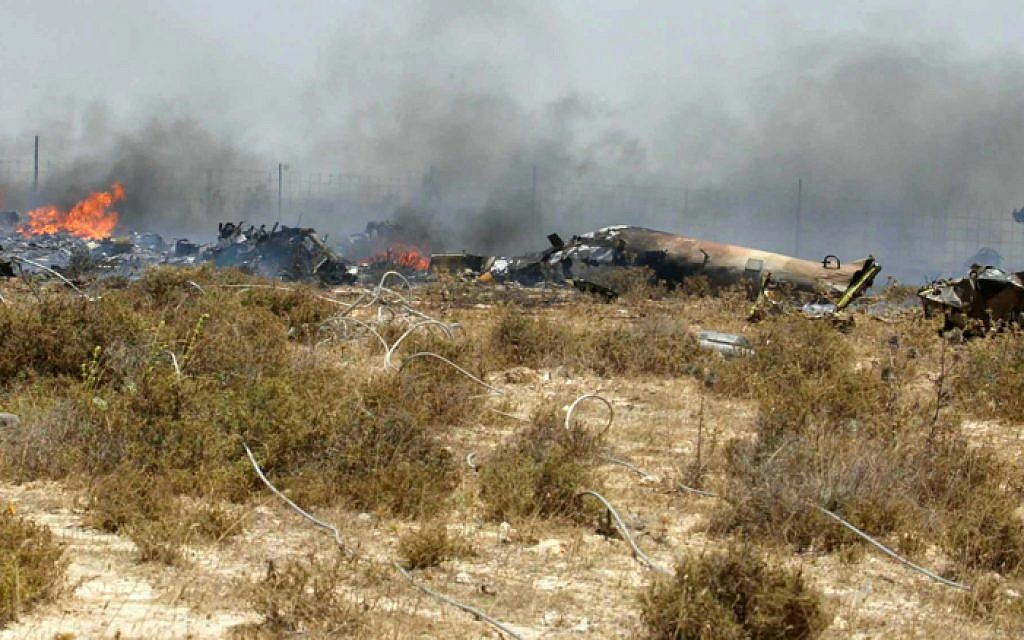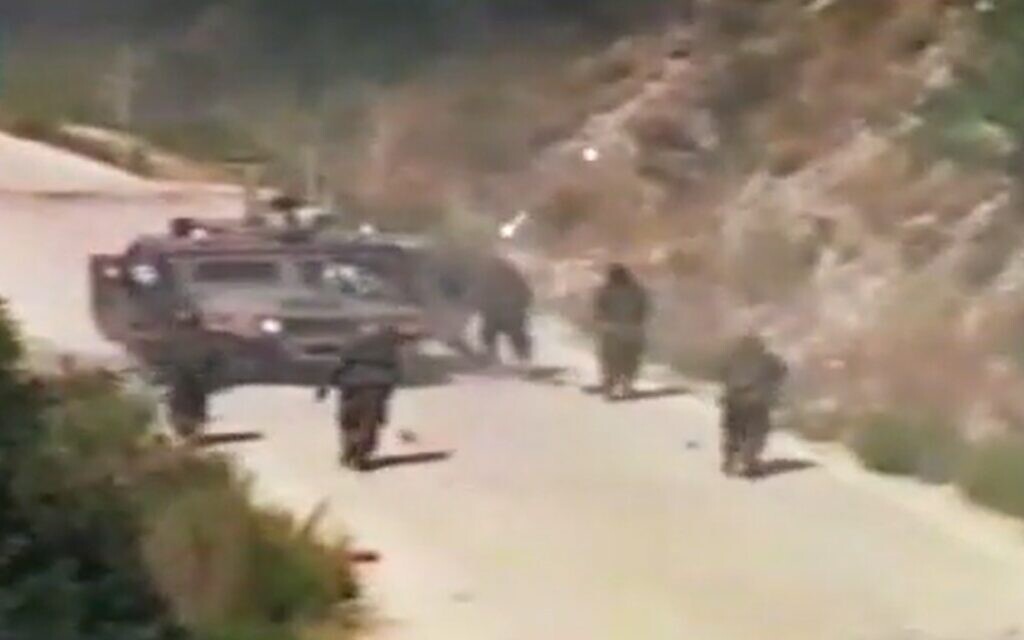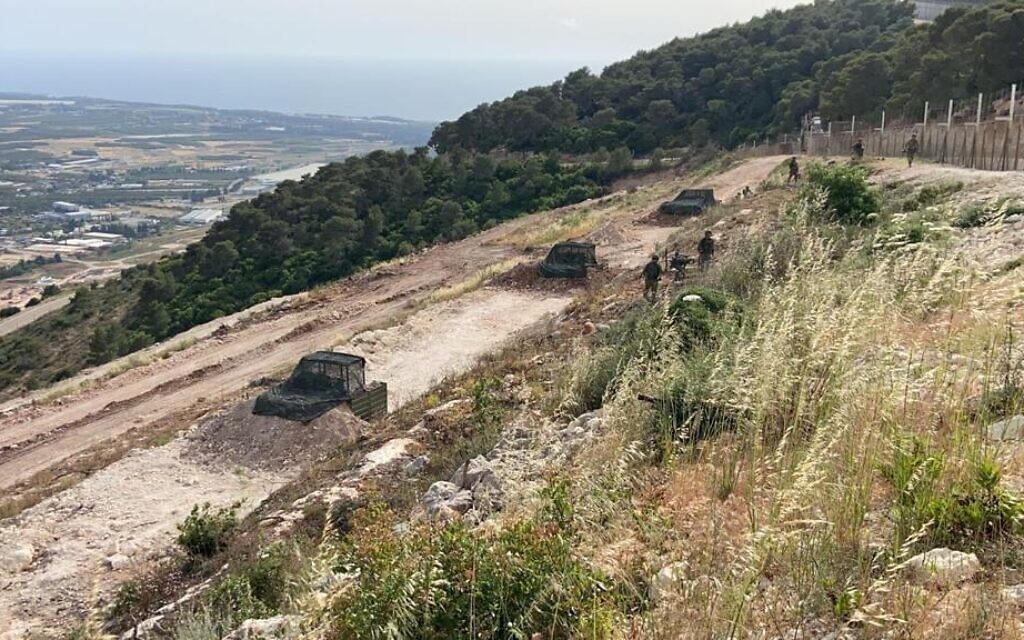- Military does not believe conflict is imminent, but says Iran-backed terrorist militia, against which it fought a war in 2006, has an arsenal of roughly 140,000 missiles
THE PIT, IDF NORTHERN COMMAND, SAFED — In a future war with Hezbollah, more rockets and missiles would be fired at Israel from Lebanon in the span of less than two days than were fired during the entire 11-day battle between Israel and Palestinian terrorist groups in the Gaza Strip in May, according to fresh Israeli military assessments.
However, the Israel Defense Forces does not anticipate such a conflict to break out imminently, believing the domestic crises currently unfolding within Lebanon make the prospects of war less likely. The internal upheaval in Lebanon is, however, broadly a source of concern for the military, adding yet more chaos and uncertainty to an already fraught situation just across the border.
Though it has long seen governmental negligence and sectarian division, Lebanon in recent months has faced a nearly total breakdown of its financial system, complete political deadlock, a massive fuel shortage and a poor response to the coronavirus pandemic, as well as last August’s massive explosion in the Beirut port, which caused hundreds of deaths and widespread destruction in the city.
Though European countries and international bodies have stepped in to assist Beirut in the past, they have largely kept their distance in recent months over concerns that the underlying causes of Lebanon’s dysfunction are not being addressed, among them the control that Hezbollah wields over large parts of the country.
These conditions have led to a major split within Lebanese society, with most of the population unable to afford basic goods, while those affiliated with Hezbollah have a comparatively far easier existence. To demonstrate these differences between Hezbollah and the rest of Lebanon, the IDF notes that the head of the Lebanese Armed Forces earns roughly $677 a month, while a low-ranking Hezbollah operative earns roughly $500. Hezbollah also maintains its own chains of grocery stores, which are effectively only opened to its members and their families, allowing them to better weather the country’s financial crisis.
“Hezbollah is preventing stability in Lebanon and endangering the lives of Lebanese citizens as it hides behind them,” Maj. Gen. Amir Baram, the head of the IDF’s Northern Command, told reporters this week, marking 15 years since start of the 2006 Second Lebanon War.
In the time since the war, Hezbollah has turned from a terror group into a full-blown terrorist army, with a massive arsenal of rockets and missiles that can hit every Israeli population center, and significant wartime experience from its nearly 10 years fighting in Syria on behalf of its ally, dictator Bashar Assad. Israeli soldiers return from southern Lebanon on August 14, 2006, after a UN-imposed ceasefire went into effect bringing an end to the Second Lebanon War. (Pierre Terdjman/Flash90)
Israeli soldiers return from southern Lebanon on August 14, 2006, after a UN-imposed ceasefire went into effect bringing an end to the Second Lebanon War. (Pierre Terdjman/Flash90)
The 2006 Second Lebanon War is considered by the IDF to have been a wakeup call: Many of the troops fighting in it were improperly trained and outfitted, orders they received were unclear or contradictory, and communication within the military was particularly poor, with critical pieces of intelligence failing to reach the units that needed them most. Advertisement
And yet the results of the war were unquestionable: Hezbollah has refrained from conducting attacks on Israel, with exceedingly few exceptions, over the past 15 years, which has allowed communities on the northern border to thrive in a way they never had before.
“After the Second Lebanon [War], Hezbollah learned a lesson that has held for 15 years. If there is another war, it will pay an even greater price,” Baram said.
“Our message to Hezbollah is this: In the next campaign, you will encounter a military that is better trained, more lethal and more determined than ever before,” he said.
One area in which the military has invested considerable resources is in locating Hezbollah targets in Lebanon, giving the IDF the ability to rapidly strike a huge number of sites in a short period of time. The military says it now has intelligence on “thousands of targets,” 20 times more than it had at the start of the 2006 war.
The IDF revealed the location of one of these on Wednesday, a large weapons depot in central Lebanon, across the street from a school.
Yet the military stresses that a future war with Hezbollah would be dire, with Israeli soldiers and civilians killed at levels that many Israelis have never before experienced, with widespread destruction and major disruptions to the country’s day-to-day functioning. Advertisement  Soldiers and rescue team members at the scene of an army helicopter crash during the Second Lebanon War in July 2006. (Haim Azulai/Flash90)
Soldiers and rescue team members at the scene of an army helicopter crash during the Second Lebanon War in July 2006. (Haim Azulai/Flash90)
In such a conflict, the IDF’s primary goal would not necessarily be to stop Hezbollah from launching rockets at the Israeli home front but rather to destroy its ability to wage war more broadly, meaning even as the military pummels the group, projectiles would still be flying at towns and cities throughout the country.
Should such a conflict break out, or even if there were a smaller skirmish, it would largely be managed from what’s known as The Pit under the Northern Command’s headquarters in the northern Israeli city of Safed. It is a multi-storied labyrinth of hallways and command centers buried deep below Mount Canaan, dug directly into the living rock, which in a flash can be filled with thousands of troops who would oversee and coordinate the combat. The Pit is capable of functioning independently, with backup generators and emergency provisions, for extended periods of time.
A preemptive strike
According to Israeli military assessments, Hezbollah maintains an arsenal of 130,000 to 150,000 projectiles of various varieties and ranges, from mortar shells to simple rockets with ranges of 200 kilometers (120 miles) to cruise missiles, shore-to-sea missiles, armed unmanned aerial vehicles and a small number of precision-guided missiles, the latter being of the utmost concern to the IDF.
With these, should a war break out, the IDF believes Hezbollah could fire 1,000 to 3,000 rockets and missiles every day for at least the first week of fighting. (In comparison, Hezbollah fired roughly 4,000 rockets in total during the entire 34-day Second Lebanon War, which was at the time an unprecedented level of attack.)
For years, Hezbollah and its patron Iran have been developing precision-guided missile capabilities — both methods of producing the weapons from scratch and methods of converting existing simple rockets into these far more accurate munitions. The IDF has repeatedly warned of the threat posed by these weapons, which could easily overwhelm Israel’s air defenses, saying they were the next most serious risk to the country’s security after the prospects of an Iranian nuclear weapon. Israel has also reportedly conducted strikes in Syria — and at least once in Lebanon — to prevent Hezbollah from obtaining the capabilities needed to manufacture these precision-guided missiles.
Israel in general refrains from operating in Lebanon and from intentionally killing Hezbollah operatives for fear of retaliation by the organization, so in recent years, it has attempted to halt Hezbollah’s progress within Lebanon by revealing the locations of its facilities. The IDF believes that by identifying them, it will force Hezbollah to abandon the sites. Such was the case in 2018 and 2020, when then-prime minister Benjamin Netanyahu exposed several of these locations in speeches to the United Nations General Assembly, which reportedly led Hezbollah to indeed halt their activities at the sites. An alleged Hezbollah weapons depot (outlined in red) is seen across the street from a school (outlined in yellow) in the central Lebanese town of Ebba in a satellite image from June 1, 2020. (Google Earth, outlines added by The Times of Israel)
An alleged Hezbollah weapons depot (outlined in red) is seen across the street from a school (outlined in yellow) in the central Lebanese town of Ebba in a satellite image from June 1, 2020. (Google Earth, outlines added by The Times of Israel)
However, the IDF believes Hezbollah is in possession of at least several dozen of these weapons and is suspected of working to produce more, raising the consideration among military and political officials of the possibility of a preventive strike against the organization to definitively deny it this capability. However, though the option has been discussed, the IDF top brass does not believe that this is necessary at this stage, believing it can effectively counter whatever missiles Hezbollah currently has.
The military recognizes that its assessments of Hezbollah’s intentions are imperfect, that under the right — or wrong — set of circumstances a war could anyway break out, one for which the IDF has been preparing for the past 15 years.
How the 3rd Lebanon war would unfold
The IDF’s basic timeline for a war against Hezbollah looks like this: After some kind of attack on the border, possibly a surprise assault, by Hezbollah — similar to the Second Lebanon War, which began with an ambush on an IDF patrol — Israel would respond forcefully with a strike on the group in Lebanon. Advertisement
Hezbollah would then retaliate further, potentially launching rockets at the Israeli home front. Israelis from communities near the border would likely leave the area en masse, causing traffic snarls and other logistical issues. Footage aired by Hezbollah-affiliated al-Manar on July 12, 2021, shows the attack on an IDF jeep on July 12, 2006 that sparked the Second Lebanon War. (Screen grab)
Footage aired by Hezbollah-affiliated al-Manar on July 12, 2021, shows the attack on an IDF jeep on July 12, 2006 that sparked the Second Lebanon War. (Screen grab)
Hezbollah would then deploy its Radwan Unit, a special forces detachment that has been specifically trained to capture portions of the Galilee in order to score a public victory over Israel — however fleeting — and to prevent Israel from immediately launching its own ground invasion of southern Lebanon.
Whether this effort by Hezbollah succeeded or not, the IDF would then indeed launch a ground invasion of southern Lebanon, which lies on a ridge overlooking Israeli communities, giving it the strategic high ground.
“The strike from the air would be powerful in the first hours of the fighting. But in order to defeat the enemy, on the operative level, a ground invasion would be necessary,” said Brig. Gen. Dan Noyman, head of the Northern Command’s 36th Division, which would play a critical role in any future conflict in Lebanon.
Since entering his position in 2019, Baram — a military man straight from central casting, small-statured, wiry, with close-cropped salt-and-pepper hair — has been doggedly focused on preparing his Northern Command for war.
This has included revising, reviewing and approving the IDF’s plans for a future war against Hezbollah, bringing up to date the military’s tactics and larger strategies for fighting the powerful Shiite terrorist militia. Maj. Gen. Amir Baram, commander of the army’s Northern Corps and head of the IDF military colleges, in an undated photograph. (Israel Defense Forces)
Maj. Gen. Amir Baram, commander of the army’s Northern Corps and head of the IDF military colleges, in an undated photograph. (Israel Defense Forces)
This process began under his predecessor, Maj. Gen. Yoel Strick, and it is due to be completed by the end of the summer.
In addition, by the end of this year, the Northern Command chief will have submitted every combat unit under his command — regular and reservist — to an examination, known as the Northern Command Threshold Examination, assessing their ability to fight using realistic simulations. Not every unit has passed, though the IDF would not say how many failed, with some battalion commanders being told to prepare for a second round of testing. So far nearly every regular combat unit has been through the examination — one test was delayed due to May’s Gaza conflict — and the reservist brigades were scheduled to be assessed in the fall.
To better prepare the border area for conflict, the IDF has improved its defenses along the frontier, setting up additional fighting positions in the land between the internationally recognized Blue Line — the de facto border — and the security fence that runs along it. IDF defense positions set up along the Lebanese border in an undated photograph. (Israel Defense Forces)
IDF defense positions set up along the Lebanese border in an undated photograph. (Israel Defense Forces)
The military hopes to significantly expand the barrier along the border, replacing the existing chain-link fence with a concrete wall in most places. This plan has long been in the works, but has so far failed to receive the NIS 3 billion ($918 million) budget it needs to proceed.
The IDF has also deployed far more artillery cannons to the border area than in the past, allowing the military to respond more forcefully and more quickly, without needing to wait for planes and attack helicopters to get airborne.
In another time-saving measure in the case of a border attack, the IDF has also developed what it calls “Dvora Units,” small combat teams made up of veterans of elite units who live in communities along the Lebanese border and are thus capable of responding quickly, a senior Northern Command officer told reporters, speaking on condition of anonymity.
According to the officer, these units are also meant to allow at least a small number of residents of these border communities to remain close to their homes should war break out, while the rest of the people who live there are evacuated to safer parts of the country.
In a lesson learned from May’s conflict in Gaza, the IDF plans to proactively establish its justifications for attacks ahead of and during wars. In May, the IDF drew major international criticism for an airstrike on a building in Gaza City that housed a number of major media outlets, including the Associated Press, which Israel says also contained Hamas and Palestinian Islamic Jihad intelligence offices.
It took several days before the military released information about the building. The IDF now believes that it should act much faster to provide evidence and reasons for conducting attacks. IDF troops train for a war against Hezbollah in northern Israel in an undated photograph. (Israel Defense Forces)
IDF troops train for a war against Hezbollah in northern Israel in an undated photograph. (Israel Defense Forces)
More generally, the IDF has prepared for a next Lebanon war by significantly improving its training methods, both devoting more time to training and making simulations more realistic.
In the Second Lebanon War, soldiers were sent to fight in the dense underbrush of southern Lebanon without ever before having fought in such wooded, hilly terrains. To address this, the IDF recently opened a new training facility known as “Galilee Forests,” near the Lebanese border, allowing troops to practice fighting in the type of topography and landscape they will actually face in combat.





